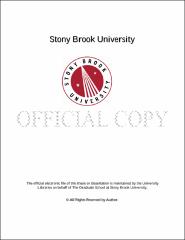| dc.identifier.uri | http://hdl.handle.net/11401/77354 | |
| dc.description.sponsorship | This work is sponsored by the Stony Brook University Graduate School in compliance with the requirements for completion of degree. | en_US |
| dc.format | Monograph | |
| dc.format.medium | Electronic Resource | en_US |
| dc.language.iso | en_US | |
| dc.publisher | The Graduate School, Stony Brook University: Stony Brook, NY. | |
| dc.type | Thesis | |
| dcterms.abstract | The goal of this study is to assess economic inequality levels in rural southern Iraq after the Arab Islamic conquest. This assessment stems from an examination of variability in domestic rooms and courtyards between the pre-conquest Sasanian (224 – 636 CE) and post-conquest Early Islamic (636 – 836 CE) periods. To achieve this goal, ethnoarchaeological and excavation data from the region are utilized to search for parallels between room and courtyard sizes. The ethnoarchaeological data are vital to establishing the correlation between courtyard and house sizes that are needed to effectively analyze the satellite-derived settlement data from the area's Sasanian and Early Islamic villages. The correlation stems from the fact that if large courtyards are associated with larger houses in the ethnographic data, then high variability patterns will suggest the presence of larger houses in satellite-derived data. The frequency of large spaces is then compared between settlements, and between each era. Then it becomes possible to examine the changes between each period by measuring inequality through standard deviations to measure variability, and Gini coefficients to measure economic differentiation. Standard deviations provide a sense of room size variability in the satellite-derived data, which are then used to compare sites, while Gini coefficients take this further as they are specifically designed to measure economic inequality. Since these sites' urban counterparts have been shown to experience rising economic inequality in the Early Islamic era in historical sources, it is likely the rural south experienced similar conditions. Indeed, my analysis of the satellite-derived data, extracted from traced architecture in high-resolution imagery, has provided new evidence supporting that hypothesis. Lastly, relevant socio-political context of each era will be cited, including an emphasis on Muslim Arab immigration into Iraq’s southern countryside, providing us a better understanding of the study's results. | |
| dcterms.abstract | The goal of this study is to assess economic inequality levels in rural southern Iraq after the Arab Islamic conquest. This assessment stems from an examination of variability in domestic rooms and courtyards between the pre-conquest Sasanian (224 – 636 CE) and post-conquest Early Islamic (636 – 836 CE) periods. To achieve this goal, ethnoarchaeological and excavation data from the region are utilized to search for parallels between room and courtyard sizes. The ethnoarchaeological data are vital to establishing the correlation between courtyard and house sizes that are needed to effectively analyze the satellite-derived settlement data from the area's Sasanian and Early Islamic villages. The correlation stems from the fact that if large courtyards are associated with larger houses in the ethnographic data, then high variability patterns will suggest the presence of larger houses in satellite-derived data. The frequency of large spaces is then compared between settlements, and between each era. Then it becomes possible to examine the changes between each period by measuring inequality through standard deviations to measure variability, and Gini coefficients to measure economic differentiation. Standard deviations provide a sense of room size variability in the satellite-derived data, which are then used to compare sites, while Gini coefficients take this further as they are specifically designed to measure economic inequality. Since these sites' urban counterparts have been shown to experience rising economic inequality in the Early Islamic era in historical sources, it is likely the rural south experienced similar conditions. Indeed, my analysis of the satellite-derived data, extracted from traced architecture in high-resolution imagery, has provided new evidence supporting that hypothesis. Lastly, relevant socio-political context of each era will be cited, including an emphasis on Muslim Arab immigration into Iraq’s southern countryside, providing us a better understanding of the study's results. | |
| dcterms.available | 2017-09-20T16:52:33Z | |
| dcterms.contributor | Zimansky, Paul | en_US |
| dcterms.contributor | Stone, Elizabeth C | en_US |
| dcterms.contributor | Hildebrand, Elisabeth. | en_US |
| dcterms.creator | Al-Nassar, Abdul-Hameed Salman | |
| dcterms.dateAccepted | 2017-09-20T16:52:33Z | |
| dcterms.dateSubmitted | 2017-09-20T16:52:33Z | |
| dcterms.description | Department of Anthropology | en_US |
| dcterms.extent | 101 pg. | en_US |
| dcterms.format | Monograph | |
| dcterms.format | Application/PDF | en_US |
| dcterms.identifier | http://hdl.handle.net/11401/77354 | |
| dcterms.issued | 2017-05-01 | |
| dcterms.language | en_US | |
| dcterms.provenance | Made available in DSpace on 2017-09-20T16:52:33Z (GMT). No. of bitstreams: 1
AlNassar_grad.sunysb_0771M_13221.pdf: 2953648 bytes, checksum: 5c9341bdb3264eba9ad2967b757b4225 (MD5)
Previous issue date: 1 | en |
| dcterms.publisher | The Graduate School, Stony Brook University: Stony Brook, NY. | |
| dcterms.subject | Archaeology | |
| dcterms.subject | Arab, Ethnoarchaeology, Historical, Islamic, Persian, Sasanian | |
| dcterms.title | An Archaeological Examination of Economic Inequality as Seen in Domestic Early Islamic Housing in Rural Southern Iraq | |
| dcterms.type | Thesis | |

